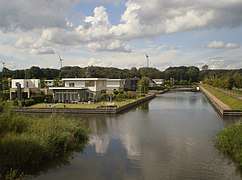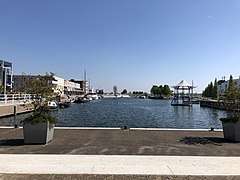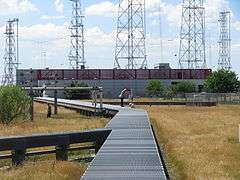Zeewolde
Zeewolde (Dutch pronunciation: [zeːˈʋɔldə] (![]()
Zeewolde | |
|---|---|
Horsterwold forest | |
 Flag  Coat of arms | |
.svg.png) Location in Flevoland | |
| Coordinates: 52°20′N 5°33′E | |
| Country | Netherlands |
| Province | Flevoland |
| Established | 1 January 1984 |
| Government | |
| • Body | Municipal council |
| • Mayor | Gerrit Jan Gorter |
| Area | |
| • Total | 268.86 km2 (103.81 sq mi) |
| • Land | 248.54 km2 (95.96 sq mi) |
| • Water | 20.32 km2 (7.85 sq mi) |
| Elevation | 2 m (7 ft) |
| Population (January 2019)[4] | |
| • Total | 22,309 |
| • Density | 90/km2 (200/sq mi) |
| Time zone | UTC+1 (CET) |
| • Summer (DST) | UTC+2 (CEST) |
| Postcode | 3890–3899 |
| Area code | 036 |
| Website | www |

Zeewolde is known for its landscape and nature art; the most well-known art work is Sea Level by Richard Serra, located in the Landschapspark De Wetering.
In the wood Hulkesteinse Bos there is the naturist resort Flevo-Natuur, with recreation bungalows, a camp site, and the possibility of day recreation.[5]
History
The municipality of Zeewolde was founded in 1984 and is therefore one of the youngest in the Netherlands. Before 1984, the area was administrated by the Openbaar Lichaam Zuidelijke IJsselmeerpolders (OLZIJ) (English: Public Body of Southern IJsselmeer Polders), founded by the Dutch national government after the province of Flevoland was created. The name 'Zeewolde' was always meant to be used during the planning stages, but on various locations.
Zeewolde's first inhabitants were the so-called 'pioneers', moving in from the 'old land' to the newly created polder in 1979. They were mostly farmers and in the beginning stages deprived of amenities such as electricity or tap water. The planned village was then mostly meant to provide services to the neighbouring farmers. Alongside the farmers, two holiday resorts were founded in the area.
In August 1980, the Zeewolde advisory board, headed by Han Lammers who was at the time the head of the OLZIJ, met for the first time. In February 1982, municipal elections were held and the first streekplan (Structural plan) was drawn, envisaging the village to grow to 15.000 inhabitants. The actual village itself was started in 1983, after which in 1984 Zeewolde became a municipality in its own right. On 23 February 1984, the official first inhabitant of the village of Zeewolde was handed the keys of his house.
Transportation
There are no railway stations in the municipality, but the nearest stations are Harderwijk, Nijkerk and the stations in Almere. There are busconnections to the stations in Harderwijk and Nijkerk, and to the central station in Almere.
Notable people
- Tom Viezee (born 1950) Christian minister and former politician, Mayor of Zeewolde 1999-2004
- Geke Faber (born 1952) politician, Mayor of Zeewolde 1990-1998
- Tim Visser (born 1987 in Zeewolde) rugby union player who plays for the Scotland national team
- Sabrina van der Donk (born 1988 in Zeewolde) model who participated in the Miss Earth 2006
- Sep Visser (born 1990 in Zeewolde) rugby union player with Edinburgh Rugby
Gallery
 Overzicht toren van kerkencentrum Open Haven gezien vanaf plein - Zeewolde
Overzicht toren van kerkencentrum Open Haven gezien vanaf plein - Zeewolde Harderwold
Harderwold Zeewolde-haven
Zeewolde-haven Jan Joris Vereijken
Jan Joris Vereijken
References
- "Samenstelling College van B&W" [Members of the board of mayor and aldermen] (in Dutch). Gemeente Zeewolde. Retrieved 5 September 2013.
- "Kerncijfers wijken en buurten" [Key figures for neighbourhoods]. CBS Statline (in Dutch). CBS. 2 July 2013. Retrieved 12 March 2014.
- "Postcodetool for 3891ER". Actueel Hoogtebestand Nederland (in Dutch). Het Waterschapshuis. Retrieved 5 September 2013.
- "Bevolkingsontwikkeling; regio per maand" [Population growth; regions per month]. CBS Statline (in Dutch). CBS. 1 January 2019. Retrieved 1 January 2019.
- Flevo-Natuur

